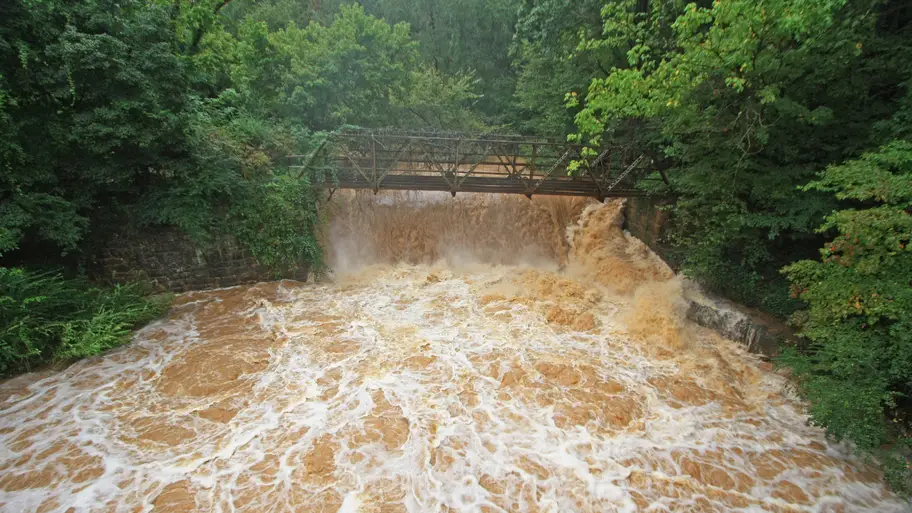Do you need flood insurance in Georgia?
Hurricanes in Georgia are relatively uncommon, but the state experiences other forms of severe weather that can cause flooding. In fact, the Federal Emergency Management Agency (FEMA) notes that 99% of U.S. counties have been impacted by a flooding event between 1996-2019. Hurricanes Katrina, Floyd, and Alberto all left their mark on Georgia, with roughly three million people evacuating in 1999 for Floyd alone. Since 2017, Georgia has experienced seven large flooding events, including over 550 reports of flash flood incidents.
Surprisingly, the most flood-prone areas in Georgia are not located along the coastline. The majority of high-risk flood areas are located in the northern part of the state, including Fulton County, Gwinnett County, Cobb County and Dekalb County, according to the Federal Emergency Management Agency (FEMA).
If you are a Georgia homeowner, it may be important to learn more about the risk of floods in your region to understand whether or not you have a need for flood insurance. If a flood event causes damage to the structure of your home or your personal belongings, you would be responsible for covering the cost of repairs out-of-pocket if you do not have flood insurance.
Flood events in Georgia
According to FEMA, the most flood-prone county in Georgia is Fulton County, home of the state’s capital, Atlanta. This land-locked county is nonetheless home to smaller bodies of water and geographic characteristics that increase the risk of frequent flooding. The high population density of this area means any floods, even small ones, have a sizable impact on the population. Many of the other counties with high flood levels are all in the same region.
| County | Flood events between 1996-2019 |
|---|---|
| Fulton | 72 |
| DeKalb | 69 |
| Gwinnett | 68 |
| Cobb | 66 |
| Coweta | 61 |
| Cherokee | 55 |
| Floyd | 60 |
Cost of flood insurance in Georgia
Flood insurance in Georgia may be expensive, but it is usually cheaper than your standard homeowners insurance policy. According to the National Flood Insurance Program (NFIP), the average annual flood insurance premium is $700. In comparison, the average cost of a standard home insurance policy in Georgia is $1,394 per year for $250,000 in dwelling coverage, according to rates from Quadrant Information Services.
The cost of a flood insurance policy is based on a variety of factors, including the location and value of the home, the elevation, design and age of the home, the type of elected coverage and the deductible. Based on these variables, every homeowner in Georgia will pay a slightly different rate for their flood insurance.
What does flood insurance cover?
Flood insurance typically provides extended financial protections in addition to the homeowners insurance policy you likely already have. Georgia flood insurance covers two main categories: building coverage and contents coverage.
Among other things, building coverage in a flood policy may include the following:
- Built-in appliances such as dishwashers
- Detached garages
- Electrical and plumbing systems
- Foundation walls, anchorage systems and staircases
- Furnaces and water heaters
- Permanently installed cabinets, paneling and bookcases
- Permanently installed carpets
Contents coverage includes things like:
- Air conditioners
- Carpets not included in building coverage
- Curtains
- Valuable items such as artwork and furs (up to $2,500)
- Washer and dryer
- Your personal belongings, such as clothing, furniture and electronics
Although flood insurance may financially protect your home, there are some home elements it typically does not cover, including the following:
- Additional living expenses while your home is being repaired or is unable to be occupied
- Any personal property that was kept in your basement
- Financial losses caused by business interruption
- Property outside of the insured building: this includes landscaping, wells, septic systems, pools and decks
- Vehicles
How to purchase Georgia flood insurance
Homeowners in Georgia may be able to purchase flood insurance through a private insurer or the NFIP. The NFIP is a government-funded flood insurance program that is sold through many private insurance companies and independent agents. A good first step when buying Georgia flood insurance may be to check with your home insurance company to see if an agent can help facilitate the purchase of an NFIP policy. If so, you may find this is the simplest way to obtain a flood policy in addition to your homeowners insurance. Most flood insurance is sold as a separate standalone policy rather than an endorsement to your existing home insurance policy.
NFIP flood insurance policies
NFIP policies typically include a certain amount of dwelling coverage and personal property coverage. Any loss that is determined to be directly the result of flooding is likely covered, with only a few exceptions. An NFIP policy does not include coverage for other structures, like fences, pools or landscaping, and it does not typically cover vehicles, personal property kept in a basement, valuable items or financial loss due to business interruption.
With an NFIP policy, homeowners of a single-family unit can get up to $250,000 in dwelling coverage and up to $100,000 in personal property coverage. These policies are usually sold separately and have separate deductibles. All NFIP flood insurance policies are valid for one year, and after the policy term ends, the policy must be renewed for continued coverage.
To purchase NFIP flood insurance, you can use the online search feature to see if your insurance company sells flood insurance. Most major insurance providers, like Allstate, Auto-owners, Farmers, Liberty Mutual and USAA have a partnership with NFIP, as do some local insurance providers.
Private flood insurance policies
As an alternative, some homeowners may prefer to purchase private Georgia flood insurance policies. Compared to the NFIP, private flood insurance usually has higher coverage limit options, but may subsequently cost more. Additionally, the deductible for private flood insurance might be higher than a deductible for an NFIP policy, although this may vary by homeowner and carrier.
How to file a NFIP flood insurance claim
So how do you file a claim if you’ve experienced a flood and your home and belongings are damaged? The NFIP makes it simple to submit your claim by taking the following steps:
- Report the loss as soon as possible to the insurance company from which you bought your NFIP policy. To verify, you can call the NFIP at 877-336-2627. If necessary, your insurance provider may advise you to seek flood mitigation services to prevent additional damage from occurring.
- Make a list of damaged personal property that can be submitted with your claim.
- Once you’ve submitted your claim, an insurance adjuster will assess the damage within a day or two, either in person or remotely. Don’t discard any items until you take pictures of them to document the damage or the adjuster has seen them.
- Review the insurance adjuster’s estimate and report to be sure it is accurate. If necessary, you may be able to request a supplemental estimate be submitted on your behalf by your General Contractor if there is a significant discrepancy in estimated damages.
- Wait for your claim payout and begin cleanup. The time it takes to process your claim will depend primarily on how widespread the flooding was in your region, as well as the overall volume of claims currently in process. Aiding in the process by answering questions and providing documentation as necessary may help expedite the process.
If your flood results in an official presidential disaster declaration, you may be able to apply for FEMA disaster aid in addition to your flood claim.





